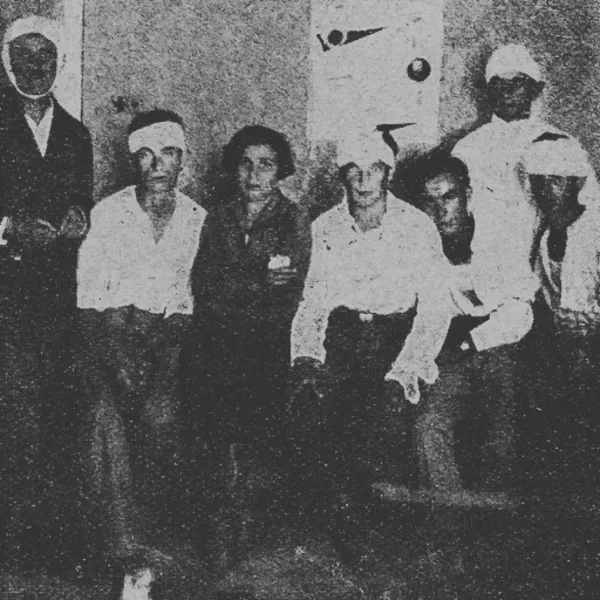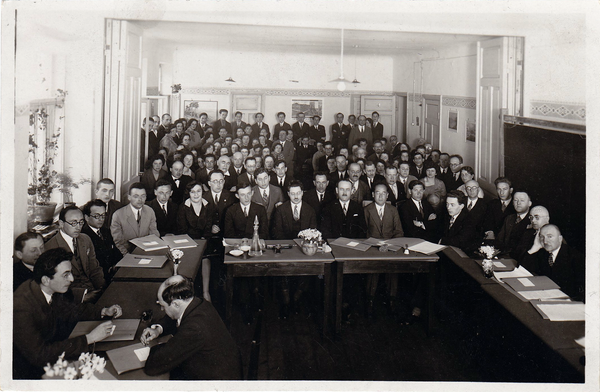Doikayt in the Desi Diaspora
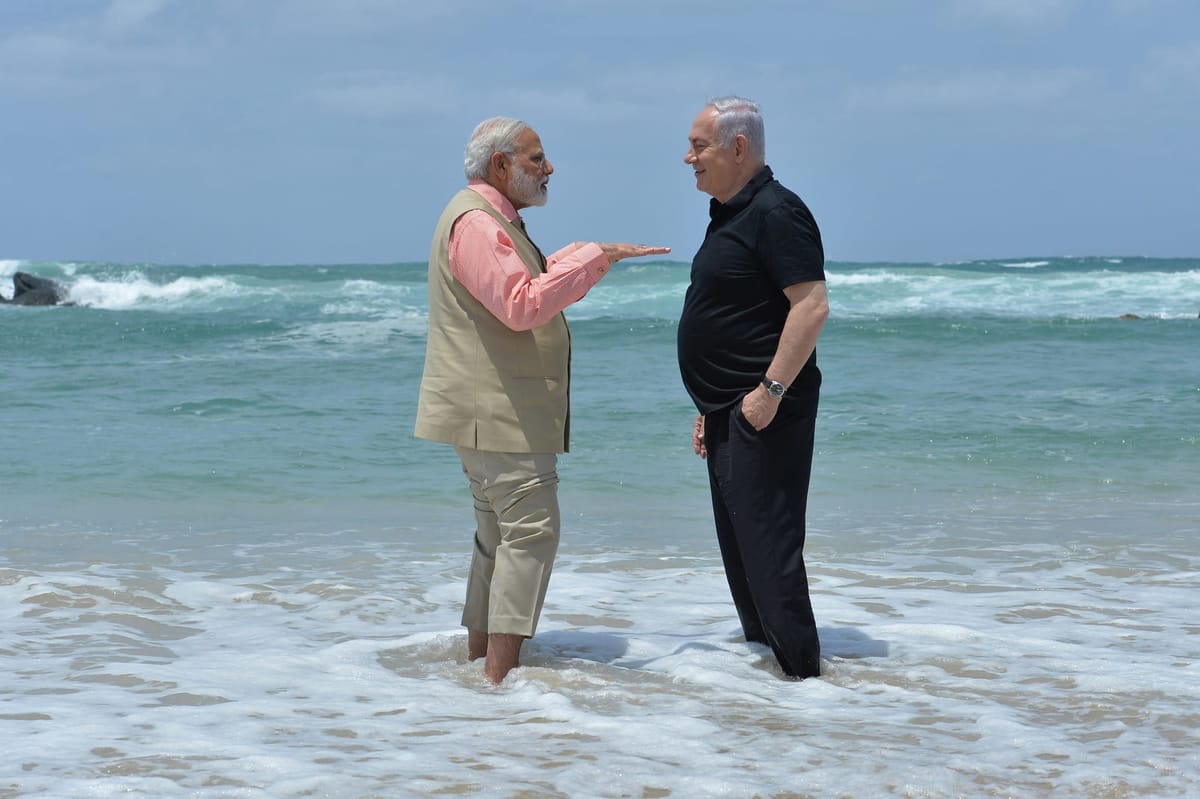
April 25, 2023, was a typical spring Tuesday outside the California State Capitol: thermostats across Sacramento climbing well into the eighties by noon, harried staffers’ and lobbyists’ hair and makeup wilting in the heat as they ducked out to grab to-go salads from one of the many nondescript lunch cafés nearby.
A few weeks earlier, State Senator Aisha Wahab, a freshman Afghan-American progressive representing the southeastern Bay Area, introduced Senate Bill 403, a simple piece of legislation to add “caste” to the list of categories protected by California anti-discrimination law. This particular Tuesday, the hearing room and outside halls were packed with hundreds of South Asian Americans, filling the twin support and opposition public-comment lines with impassioned arguments to stop rampant discrimination against members of the South Asian community. To a casual observer, and even some legislators themselves, the whole scene was rather confusing. Why were both sides arguing that they were the true victims of bigotry and discrimination?


Left: California State Senator Aisha Wahab. Photo in the public domain. Right: US-India Security Council President Ramesh Kapur. Photo via LinkedIn.
Two months earlier, Seattle became the first American city to formally ban discrimination on the basis of caste — a millennia-old system of endogamous intergenerational social hierarchy that encompasses aspects of class, race, ancestry, region, occupation, diet, even the state of a human being’s eternal soul — inspiring many South Asian communities in California who had experienced caste discrimination to attempt the same. Public momentum for a caste discrimination ban had been building in California for years: in 2020, the state’s Civil Rights Department launched a landmark lawsuit against Cisco Systems and two of its engineers, alleging that the engineers had harassed and denied pay and promotions to a subordinate belonging to the Dalit community – the lowest rung in the caste system, outside and beneath the four varnas (social classes) that constitute the caste hierarchy. Workers, tenants, and students were going public with similar accounts of caste discrimination running rampant at Google and other Silicon Valley companies. The California State University system officially added caste to its anti-discrimination policy in 2022, thanks to the organizing of Dalit student activists. It seemed past time to formally enshrine protection against caste discrimination in California state law.
But it also faced fierce opposition from mostly upper-caste “Hindu-Americans,” as they call themselves. Wahab was flooded with death threats and intimidating visits to her office. Opponents from Wahab’s disproportionately South Asian-American district even launched a failed recall attempt against her.
Like Zionism, Hindutva in the US is dependent on spinning revanchist historical myths for the diaspora while weaponizing the anti-discriminatory concept of "Hinduphobia" to keep liberals onside while stifling leftward criticism from the groups it seeks to marginalize, namely Sikhs, Muslims, and lower-caste Hindus. Like Zionism, Hindutva is constituent to the twin projects of the "multiracial far right" within the United States and an emerging internationalist right-wing realignment that includes the repression of Palestinians and Indian Muslims.
Even some ostensibly progressive members of the California Legislative Asian American and Pacific Islander (AAPI) Caucus, many representing Silicon Valley and Bay Area districts with large South Asian constituencies, caved under pressure to undermine SB 403. Cynically claiming that the bill was dividing the AAPI community, they demanded it be watered down to list caste as merely a subcategory of “ancestry.” Advocates for the bill immediately recognized this amendment as a gross oversimplification of caste, but had little choice but to accept it under the circumstances. So amended, SB 403 sailed through the state legislature, only to be vetoed by Governor Gavin Newsom, who dubiously claimed that protection against caste discrimination was already covered by existing law. It didn’t take long to figure out what really happened.
Soon after Newsom’s veto, the Washington Post reported that Ramesh Kapur, a major Biden and Harris fundraiser and president of the US-India Security Council, had approached Newsom personally at a Biden fundraising dinner and lobbied him to veto SB 403, even receiving a personal heads-up email from Newsom’s office hours before the veto was publicly announced. Kapur later attempted to deny this claim when asked by a Washington Post reporter, and Newsom predictably denied that he had been unduly influenced. Romesh Japra, a political gadfly based in Wahab’s district who campaigned for Trump in 2020 and founded a Super PAC called Americans4Hindus, openly bragged about mobilizing with like-minded Democratic counterparts to kill the bill in online interviews.
The bipartisan tag-team effort to veto a “Hinduphobic” bill that would have prevented discrimination against other South Asian Americans, including fellow Hindus, speaks to the growth of an organized “Hindu-American” political bloc. While South Asian-Americans lean Democratic like most Asian-American ethnic communities, they have steadily risen to high-profile representation in nearly every band of the American political spectrum. Between Kamala Harris, Vivek Ramaswamy, Nikki Haley, Bobby Jindal, Pramila Jayapal, Usha Vance, Ro Khanna, Zohran Mamdani, and Kshama Sawant – just to name a few – socialists, progressives, centrists, Never Trump Republicans, and MAGA die-hards can count a prominent South Asian-American in their ranks. Most Americans don’t tend to think of South Asian-Americans as having a distinct politics tied to their identity, and many South Asian-Americans, especially second-generation South Asian-Americans, didn’t necessarily grow up with a strong sense that they needed to have one.
The Hindu-supremacist movement in the United States is a satellite of the project of Hindutva, an ethno-nationalist movement which predates the simultaneous decolonization and violent partition of South Asia in 1947. It was one of many competing visions, socialist and fascist, radical and reactionary, theocratic and egalitarian alike, fighting for dominance in the subcontinent as the British Raj finally crumbled in the aftermath of World War II. While Hindutva remains unknown to most Americans – including politicians who wittingly or unwittingly enable it – it is working to radicalize formerly apolitical Hindu South Asian-Americans in the diaspora by repurposing "model minority" meritocratic success in service of anti-solidaristic domestic politics in the U.S., as well as the muscular chauvinism exemplified by Indian Prime Minister Narendra Modi, his ruling Bharatiya Janata Party (BJP), and the BJP’s century-old paramilitary base-building movement, the Rashtriya Swayamsevak Sangh (RSS). By inculcating a sense of grievance in their base by suggesting that “Hindu-Americans” are under attack by ethnic-studies curricula, affirmative action, anti-caste discrimination laws and other initiatives, Hindu nationalist groups in the US both weaponize the language of discrimination and xenophobia to appeal to liberalism while also preserving the model-minority image of Hindu South Asian-Americans as self-made meritocrats to appeal to conservatism. Their approach to the issue of caste lays this incoherence bare.
Like Zionism, Hindutva in the US is dependent on spinning revanchist historical myths for the diaspora while weaponizing the anti-discriminatory concept of "Hinduphobia" to keep liberals onside while stifling leftward criticism from the groups it seeks to marginalize, namely Sikhs, Muslims, and lower-caste Hindus. Like Zionism, Hindutva is constituent to the twin projects of the "multiracial far right" within the United States and an emerging internationalist right-wing realignment that includes the repression of Palestinians and Indian Muslims. Perhaps that is why Hindu nationalist organizations, like the Hindu-American Foundation (HAF) — which led the charge against SB 403 — have partnered so seamlessly with Jewish Zionist organizations like the Anti-Defamation League and the American Jewish Committee.
Part I: Imagined Pasts, Uncertain Futures
Caste is not tracked as a demographic characteristic in the U.S., but a 2020 YouGov/Carnegie Endowment survey of Indian-Americans found that half of Hindu respondents still identified with their caste, regardless of whether they had immigrated to the United States recently or decades ago. Nonetheless, the class background of South Asian-Americans has diversified as their population has more than doubled since 2000. The momentum of the American civil rights movement paved the way for professional-class South Asians to immigrate in the late 1960s and early 1970s after decades of near-total exclusion. A second wave in the late 1980s and early 1990s, fueled in part by a global neoliberal turn and the “opening” of previously protectionist South Asian economies to international capital, was less overwhelmingly professionalized. Today, South Asians are one of the fastest-growing populations of undocumented immigrants in the United States, with increasing numbers of Indian, Pakistani, Bangladeshi, and Nepali immigrants risking border crossings and overstaying temporary visas.
While shifts in the class composition of South Asian immigration are critical to understanding diaspora politics, it still holds true that South Asians with privileges and resources back home – including caste privilege – are more likely to successfully immigrate to the U.S. For Indian-Americans, that dynamic is becoming more complicated as disadvantaged minorities, including Dalits climbing up the ladder in India’s economy, are more materially able to emigrate abroad. The same YouGov survey found that Indian-Americans with more liberal views in the American political context professed more conservative views when similar questions about “equal protection of religious minorities, immigration, and affirmative action” were posed in the context of Indian politics. With eighty percent of South-Asian Americans having origins in what is now India, many Indian-Americans carry the politics of the motherland in ways that inevitably affect the twenty percent who mostly come from Muslim-majority countries like Pakistan and Bangladesh, who have already been subjected to systematic surveillance and discrimination since 9/11 and the dawn of the War on Terror.

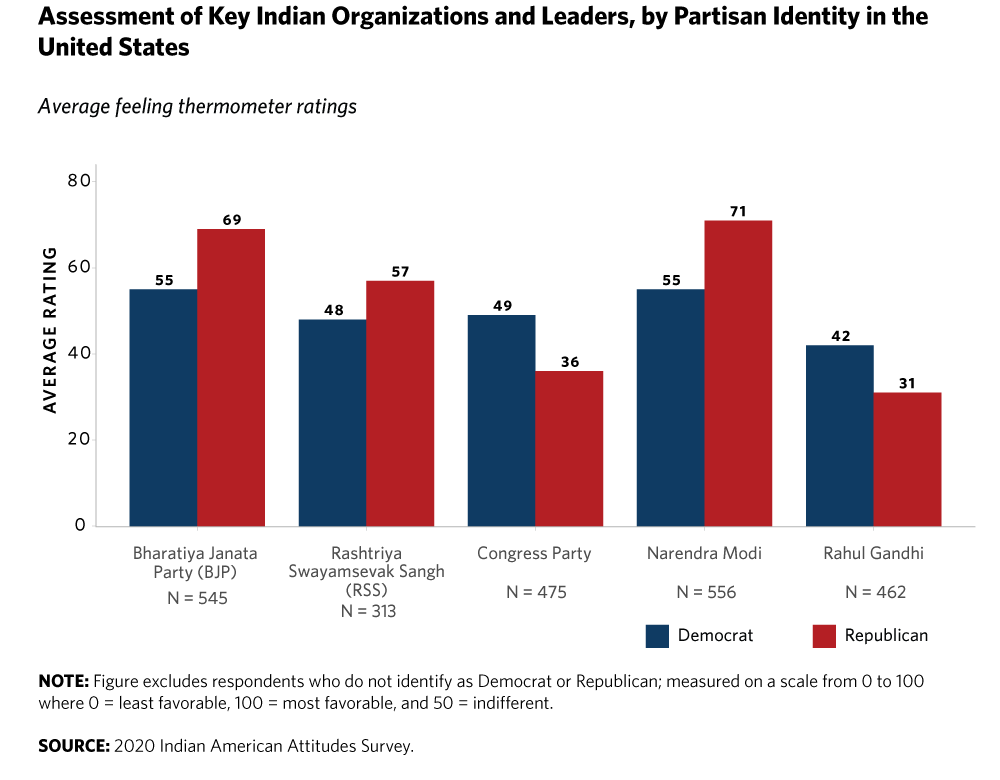
The growing ecosystem of Hindu-nationalist organizations and lobbies among the US diaspora doesn’t just benefit from ideological ambiguity around its ultimate aims; it actively cultivates this ambiguity by creating the concept of “Hinduphobia” from whole cloth. What liberal-minded elected official would object to the noble goal of fighting discrimination against religious minorities? Last fall, Democratic Congressman Shri Thanedar (Detroit, MI) launched the Congressional Hindu, Buddhist, Sikh and Jain American Caucus, with the stated objective of building “a movement that says every faith, every culture, and every community has a place in America.” On hand to offer fulsome praise at the caucus’ launch in Washington was SB 403 opponent Romesh Japra – whom Thanedar thanked personally in his remarks.
The furor surrounding SB 403 in California, in which many nominally progressive politicians balked at combating caste discrimination because they found the issue too “divisive,” points to the broader failure of liberalism to confront right-wing political projects that invert identity politics to their benefit.
Despite Thanedar’s effusive paeans to religious pluralism, the glaring absence of Muslims from the caucus was noticed by some Hindu, Muslim, and Sikh groups who were immediately suspicious of its potential as a vehicle to launder Hindu nationalism into US politics, strengthening the hand of Modi and his right-wing nationalist BJP under the guise of combating discrimination and strengthening US-India relations. After all, Thanedar himself – Rashida Tlaib’s Congressional neighbor in Detroit – has lectured Arab-American Michigan voters to see Israel’s genocidal assault on Gaza as a “fight against terrorism” while the Indian government announced billions in new weapons sales to Israel. He also recently introduced a federal bill to condemn “Hinduphobia,” stating confidently that “[Hinduism] is a very peaceful religion … It is not a religion that attacks others, it is not a religion that is aggressive against others.”
Thanedar’s remark reflects the inculcated ignorance the Hindu nationalist lobby relies on to advance its goals while obscuring the rising tide of far-right Hindu supremacy dominating Indian politics: the proposed mass stripping of citizenship from Indian Muslims, the brutal imposition of martial law in Muslim-majority Kashmir, the explosion of anti-Muslim pogroms, mass property demolitions of Muslim communities, and the blatant Islamophobic rhetoric of Modi and his Hindu nationalist power base after a decade in power. In the United States, where the dominant cultural image of South Asians is the “model minority” engineering whiz and the dominant conception of Hinduism is a hazy Orientalist picture of yoga and many-armed gods, the Hindu right can present itself as benign, even progressive. The writer Arundhati Roy – herself a subject of intense repression from the Modi government – has interrogated the lack of attention paid to caste injustice compared to other racisms and nationalisms: “Perhaps because [caste] has come to be so fused with Hinduism, and by extension with so much that is seen to be kind and good – mysticism, spiritualism, non-violence, tolerance, Gandhi, yoga, backpackers, the Beatles – that at least to outsiders, it seems impossible to pry it loose and try to understand it." The furor surrounding SB 403 in California, in which many nominally progressive politicians balked at combating caste discrimination because they found the issue too “divisive,” points to the broader failure of liberalism to confront right-wing political projects that invert identity politics to their benefit.
Part II: A Confluence of Interests
The American ruling classes see the obvious geopolitical benefits in accommodating Hindu nationalist politics and looking the other way from a growing ethno-religious lobby in the United States whose interests align with the foreign policy incentives of American hegemony. In 2023, then-President Biden rolled out the saffron carpet for Prime Minister Modi at a glitzy state dinner, attended by Democrats and Republicans alike who were more than willing to overlook the BJP’s intensifying repression of Sikhs, Muslims, and Dalits in order to buttress India’s role as a glittering success story of post-Cold War capitalist globalization and a geopolitical bulwark against China. Under Modi, the Indian government has intensified a growing alignment with not just the US but its client state, Israel.
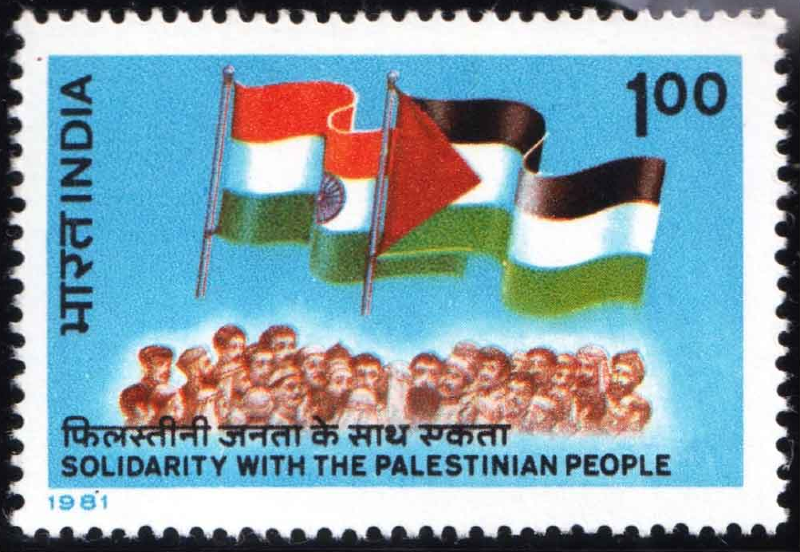
Looking at India’s anti-Muslim nationalism today, it seems almost inconceivable that India was one of the first non-Arab countries to recognize the Palestine Liberation Organization in 1974 and recognized the State of Palestine in 1988. As India liberalized its economy in the early 1990s, it shed its political commitments to non-aligned Global South movements, a trend that intensified with the BJP’s rise to power. One 1993 controversy documented in the Indian press concerned Israeli then-Prime Minister Shimon Peres’ visit to India in 1993, during which Peres was alleged to have suggested to BJP politicians that they revoke Article 370 of the Indian Constitution. Since 1954, Article 370 granted semi-autonomous governance to Jammu and Kashmir, India’s sole major majority Muslim state that is partly claimed by Pakistan and subject to endless cycles of bloody militancy and equally bloody repression since Partition. Peres’ suggestion would promote demographic change by turning Kashmir’s Muslim majority into a minority via a mass settlement project nearly identical to the one currently at work in the occupied West Bank. In 2019, the Modi government moved to do exactly that, unconstitutionally revoking Article 370 and opening Kashmir to outside settlement while putting it under martial law, with mass Internet shutdowns, intense repression of journalists, and arbitrary detentions that Amnesty International has called a “silence achieved on all dissent.” (Unsurprisingly, the HAF, in its FAQ on Article 370, hailed its reversal and the West Bank-ification of Kashmir as a victory for civil rights against Islamist extremism.)

The Adani Group, one of the most powerful business conglomerates in India and a strong ally of the Modi government, recently purchased a majority stake in the Israeli port of Haifa and manufactures weapons for Israel. Under Modi, India has also become the world’s largest purchaser of Israeli-manufactured weapons; his government even uses the Israeli-developed “Pegasus” spyware system to surveil dissenting journalists and activists in India. The dream of an “India-Middle East-Europe Economic Corridor” is a linchpin of Israel’s (and the United States’) strategy of geopolitical “normalization” with Saudi Arabia and nearby countries – so much so that Benjamin Netanyahu featured it, complete with a characteristically hokey visual prop, in his speech to the United Nations last September. Since October 7, 2023, Israel has brought in 16,000 Indian guest workers to replace banned Palestinian workers in its construction industry, with plans to hire tens of thousands more. The Indian trade union movement has pushed back, both out of solidarity with Palestinians and concerns about the exploitation of migrant workers in Israel, but with limited success so far.
As the Indian and Israeli governments grow ever closer, so do their American allies and deputies. The invention of “Hinduphobia” has its most obvious parallels with the weaponization of antisemitism to stifle criticism of Israel and its conflation with anti-Zionism. Both are projects working to manipulate traditionally liberal identity politics in America to the benefit of an increasingly internationalist right wing. Like Zionism, Hindutva is rooted in and obsessed with narratives of indigeneity, intrusion, and colonization, rewriting millennia-long histories of a diverse and multiethnic region into a single narrative of a “Hindu people” who have been consistently oppressed by “foreign invaders,” including South Asians who have been Muslims for well over a thousand years. (Recall the visitors to Afghan-American Aisha Wahab’s office, haranguing her staff with dubious history lessons about the Mughal Empire.) The Hindutva call for reclamation against what Modi himself has coined bara sau saal ki ghulami – “twelve hundred years of servitude” – clearly echoes Zionism and many other ethnonationalist, historically revisionist narratives taking hold across the global right. Just days after October 7, 2023, disinformation experts found that the top global source of false social media videos and claims about the attack was Hindu nationalists in India, and pro-Israel posts from Hindu nationalists are common enough to be memed themselves.
(idf english account) It’s important to pause when you’re eepy 🥹😔
— Shasti (@sh44sti) November 7, 2023
(idf hebrew) A Lion Will Never Pause Against A Gazelle
(indian reply guy) 🙏🏻india also lion sir https://t.co/TQiO4mKf6f
Despite their current enthusiasm for the Jewish state, the Hindu right did not always look upon Jews so warmly. Well before the violent twin births of India and Pakistan after World War II, then-ascendant European fascism inspired founders of the RSS, the century-old Hindu-supremacist paramilitary organization to which Narendra Modi has belonged since the 1960s. The RSS’ still-idolized founding fathers, M.S. Golwalkar and V.D. Savarkar, looked with admiration upon Hitler’s repression of German Jews before the war and aspired to inflict the same upon Muslims. "Germany has also shown how well-nigh impossible it is for Races and cultures, having differences going to the root, to be assimilated into one united whole, a good lesson for us in Hindusthan to learn and profit by,” wrote Golwalkar in 1939. “[T]he foreign races in Hindusthan must either adopt the Hindu culture and language, must learn to respect and hold in reverence Hindu religion, must entertain no idea but those of the glorification of the Hindu race and culture, i.e., of the Hindu nation and must lose their separate existence to merge in the Hindu race, or may stay in the country, wholly subordinated to the Hindu Nation, claiming nothing, deserving no privileges, far less any preferential treatment—not even citizen’s rights. There is, at least should be, no other course for them to adopt. We are an old nation; let us deal, as old nations ought to and do deal, with the foreign races, who have chosen to live in our country." Looking back, Golwarkar’s words wouldn’t be out of place in the mouth of Ze’ev Jabotinsky or Itamar Ben-Gvir, even if it took many decades for their revisionist acolytes to formally join forces.
The founding fathers of Hindutva were preoccupied with the defection of Dalits (excluded from caste), Shudras (the lowest caste), and Adivasis (members of indigenous South Asian tribes) to Sikhism, Buddhism, Christianity, and – most nightmarish of all in their minds – Islam. Religious conversion en masse has long been an exit strategy of sorts for lower-caste and indigenous groups and continues to be a path of escape; yet despite the caste system's rootedness in Hinduism, converts do not fully escape caste. Conversion has so alarmed the BJP that they have pushed anti-conversion laws in some states they control. In the US, “Hindu-American” groups have smeared the involvement of non-Hindu diaspora groups, especially Sikhs and Muslims, in pushing for caste discrimination bans alongside Dalit and other marginalized Hindus as discrimination from an outside force. Then, as now, both in diaspora and in the subcontinent, Hindu nationalists struggle to reconcile their upper-caste base's deep belief in the inferiority of lower-caste Hindus, Dalits and Adivasis with the need to make electoral and organizing inroads with those groups as members of a “Hindu people.”
Fighting against the tide of Hindu nationalist politics in the struggle against the British Raj, the Dalit writer, activist, political philosopher and founding father B.R. Ambedkar provocatively asserted that "The name Hindu itself is a foreign name... It was given by the Mohammedans to the natives [who lived east of the river Indus] for the purpose of distinguishing themselves. It does not occur in any Sanskrit work prior to the Mohammedan invasion. They did not feel the necessity of a common name, because they had no conception of their having constituted a community. Hindu society as such does not exist. It is only a collection of castes." Ambedkar felt that baking Hindu nationalists’ demands into the project of independence and decolonization would doom any true liberatory or democratic movement to failure, especially for Dalits. He became vociferously critical of Mahatma Gandhi, who was deeply ambivalent about caste oppression and even on occasion discouraged lower-caste and Dalit people from engaging in the very kind of nonviolent direct action for which he has become a global inspiration.
Himself an enthusiastic Dalit convert to Buddhism, Ambedkar was named India’s first Law Minister in the nominally secular and socialist government of Jawaharlal Nehru but resigned in 1951, citing the unwillingness of Prime Minister Nehru and his colleagues to adequately enshrine the rights of lower-caste and Dalit Indians in the new Constitution. In his resignation speech, a defeated Ambedkar warned that "[t]o leave inequality between class and class, between sex and sex, which is the soul of Hindu society, and to go on passing legislation relating to economic problems, is to make a farce of our Constitution and to build a palace on a dung heap.” Ambedkar did not spare his more radical comrades from critique either, lambasting what he saw as a harmful tendency among Indian Marxists and socialists to elide caste as a mere religious superstition that could be easily swept away. "The seizure of power must be by a proletariat. The first question I ask is: will the proletariat of India combine to bring about this revolution?... Can it be said that the proletariat of India, poor as it is, recognises no distinctions except that of the rich and poor? Can it be said that the poor of India recognise no such distinctions of caste or creed, high or low?"
Ambedkar’s ninety-year-old admonition to the left still matters. Caste, creed, and class still matter. The invention of the “Hindu-American” identity seeks to expel and otherize South Asian diaspora groups – not just Muslims but Sikhs — who have been targeted in assassination attempts on North American soil that have been credibly traced back to the Indian government and who have been a driving force for anti-caste discrimination laws. The anti-caste coalition SAVERA characterizes the Hindu-American project as one brick in the broader construction of a “multiracial far-right,” dovetailing with the domestic goals of MAGA to make inroads with conservative elements of nonwhite communities, which in turn is part of a burgeoning internationalist coalition of right-wing nationalisms in Europe and the global South – including, of course, India under the BJP. Lobby groups like the Hindu-American Foundation work actively in coalition with other right-leaning ethnic and religious organizations, including joining with Zionist groups in a push to eliminate Palestinian-specific topics from California’s K-12 ethnic studies curriculum. The VHP-A (Vishwa Hindu Parishad of America) – the US affiliate of the Vishwa Hindu Parishad, a major Hindu supremacist political organization in India – even celebrated the Supreme Court’s decision to overturn affirmative action, arguing that affirmative action hurt Indian-American students.
Presenting caste as a non-issue appeals to the sense of self-made success of many in the diaspora and dovetails with the American mythos of the successful “model-minority” immigrant. A 2023 Pew Research survey showed that while the majority of Indian-Americans still support affirmative action, they and other Asian-American groups opposed it specifically in college admissions. Some Asian-Americans, including South Asian-Americans, have made themselves the face of right-wing backlash against affirmative action programs in the US, mirroring concurrent discontent in India against the post-independence “reservation” system that allows (some) Dalits to access educational and employment opportunities dominated by the upper castes. Arundhati Roy’s observation that "'Merit' is the weapon of choice for an Indian elite that has dominated a system by allegedly divine authorisation” could just as well be about the American right’s weaponization of meritocracy to divide certain Asian-Americans from other minorities. "Time was when a caste Hindu crossing the oceans was said to have lost caste and become polluted,” writes Roy. “Now, the caste system is up for export. Wherever Hindus go, they take it with them."
Part III: Desi Diaspora in the Age of Trump
With Donald Trump’s return to the presidency, powered partly by an increase in support from members of minority communities, it remains to be seen how Hindu nationalists in America will navigate the contradictions inherent in pandering to anti-discriminatory rhetoric in Democratic and liberal circles while also working to strengthen the symbiosis between the ethnonationalist projects of MAGA and the BJP-RSS-VHP axis. The recent online furor around the H-1B visa program is already showing the cracks in this project. After the Trump administration announced the appointment of Indian-born Silicon Valley venture capitalist Sriram Krishnan to an advisory commission on artificial intelligence, MAGA erupted on social media over Krishnan’s Indian origin and support for the H-1B program, the lifeblood of Silicon Valley firms that depend on H-1B workers to fill engineering and other high-skilled positions. H-1B visas are tied to the employer, giving H-1B employers the leverage to pay workers less while offering them the opportunity to immigrate to the US. Seventy-five percent of all H-1B visa petitioners are of Indian origin, a fact that did not escape the attention of right-wing Americans who flooded social media with racist invective. Silicon Valley giants riding the Trump 2.0 wave seemed shocked to learn that MAGA base activists like Steve Bannon and Laura Loomer saw H-1B workers as part of a broader “Great Replacement” migrant invasion, with Elon Musk declaring “war… the likes of which you cannot possibly comprehend” on part of his own fan base and Bannon swearing to personally “take [Musk] down” in turn.
The hostility of the MAGA base to South Asians is more naked and emboldened than in recent years, but it is hardly shocking that South Asians have become targets of old-fashioned American racism and nativism. No more surprising is the response from CEOs and tech oligarchs in defense of "high-skilled" immigration programs like the H-1B visa, whose recipients' immigration status is tied to the whims and conditions set by their specific employer, making them targets of exploitation and resentment all at once – a social position long occupied by European Jews and characteristic of antisemitism’s role in refracting popular discontent. Of course, not all South Asian immigrants, let alone second- and third-generation South Asian Americans, are white-collar workers with elite educational backgrounds, even if they continue to be stereotyped, glorified, and resented as such. Are H-1B immigrants victims of nativist protectionism or potential agents of race and class division? Are they privileged members of the professional managerial class or part of an exploited labor underclass like many other immigrant groups? The real question that the H-1B discourse begs is not how South Asians in America are perceived by different political factions, but how they will choose to perceive themselves in response – and what politics will emerge from their choices. This future remains in flux.
Even the most vocal South Asian face of MAGA 2.0 found himself facing the contradictions in its politics, despite his best efforts to avoid them. Vivek Ramaswamy's swift rise to fame is in no small part due to his embrace of the model minority myth and his apparent imperviousness to the derision and outright racism directed at him by some of his conservative peers. (It helped, of course, that casting himself as a model-minority American success story was an effective distraction from his actual track record as a biotech huckster who made his fortune by hyping up a too-good-to-be-true Alzheimer's cure to gullible investors.) Ramaswamy’s blend of jingoistic American patriotism and model-minority exception is hardly unique to him. What Indian journalist Siddhartha Deb calls “the anxiety of imitation” – the individual and collective insecurities inherent in emulating the Western capitalist model of success – is as acute in the Indian diaspora as it is in the Indian middle classes at home. “The same upward mobility that has made some Indians wealthy and professionally successful,” writes Deb of the popularity of Hindu nationalism among India’s middle and upper classes, “has made them bellicose and insecure." Ramaswamy may have taken his own self-mythologizing a step too far for now by tweeting a long rant – replete with nineties jocks-versus-nerds sitcom references – about the “mediocrity” of American culture compared to that of South Asian immigrants, triggering ferocious backlash from his base that has already led the Trump administration to distance themselves from him. His personal and political project of assimilation is, despite and because of his best efforts, bound to be incomplete.
PM @narendramodi met with @VivekGRamaswamy at Blaire House today.
— Randhir Jaiswal (@MEAIndia) February 13, 2025
They had insightful discussions on India-U.S. ties, innovation, biotechnology, and the role of entrepreneurship in shaping the future.
🇮🇳 🇺🇸 pic.twitter.com/iBjrLWktlk
The sociologist Stuart Hall and other critical theorists of diaspora have sought to recast it, in Hall's words, as a "signifier of translation across differences," cultural formations that are unfixed by a single historical narrative, constructed discursively, and constantly in motion. "In breaking with the narrative of authenticity," wrote Hall in his seminal 1994 lecture The Fateful Triangle: Race, Ethnicity, Nation, "we have a critical account of diaspora that also disrupts the fatal disposition that regards diaspora peoples as continually suspended between a traditionalism of the past, to which they cannot return – impure and corrupted as they are – and a modernity of the future, equally impure and inauthentic, which they are forbidden to enter." Hindu nationalists in America are aggressively asserting their own warped narrative of authenticity. South Asian socialists organizing within specific diaspora communities already must contend with and lean into difference in a way that does not homogenize or flatten communities, while also working to unify the disparate political demands that arise from them.
A winning antidote to the “multiracial far right” that Hindu nationalism seeks to join in the US has to at once fight both the diasporic instinct to cast back to a mythical "there" of the motherland though its reinvention of history, and the internalization of "model minority" politics that demands total assimilation into the American myth of prosperity as progress and even assimilation into whiteness itself.
The kaleidoscope of languages, ethnicities, religious and cultural practices, castes and sub-castes within the South Asian diaspora requires organizers experienced in the cultural context necessary to win communities' trust. The rapid growth of undocumented and working-class South Asian immigration challenges the model minority myth, even as immigrants with middle-class backgrounds in their home countries can find it hard to conceive of themselves as working-class even when they face material hardship and exploitation. South Asian Muslims have faced the additional threat of heavy surveillance and infiltration by federal and local law enforcement since 9/11, which intimidates them from engaging in collective political action or even talking to organizers. South Asian Hindus on the left are watching as family members are increasingly radicalized into Islamophobic views. Lower-caste South Asians face workplace discrimination from high-caste South Asian colleagues and superiors, nearly always with no union organization to defend them.
Coalitions like SALAM (South Asian Left Activist Movement) are working to connect disparate strains of diaspora organizing in New York City, articulating an explicitly internationalist rejection of nation-state boundaries as a false division between South Asian diaspora communities. SALAM’s newly-launched #TataByeBye campaign is mobilizing a broad coalition of New York City-based organizations within and beyond the city’s South Asian diaspora, to agitate local events such as the NYC Marathon into divesting from contracts with the Tata Group and other India-based business conglomerates who enable the occupation and genocide in Palestine. Meanwhile, South Asian-American socialists running for office are not shying away from embracing their identity while expanding it into broader working-class politics. Pennsylvania state senator Nikil Saval openly cited the false promise of model-minority meritocracy versus the reality of economic insecurity for many South Asians as the inspiration for his socialist politics. Zohran Mamdani, the New York state assembly member currently mounting an insurgent campaign for mayor of New York City, cut his teeth organizing around economic issues like taxi medallion debt, foreclosure prevention, and gerrymandering that disproportionately affected South Asians in his community. Mamdani has made his Muslim and desi identity a core component of his public image while challenging the limits of representation: “[Former Louisiana Governor] Bobby Jindal could be my uncle, but it did nothing for me, because his political ideology is opposed to mine. Narendra Modi comes from the same state in India that my father’s family does, but his political rise was predicated on the killing and targeting of Muslims… We have to ensure that we are not simply there to put a brown face in a white legislative body.”
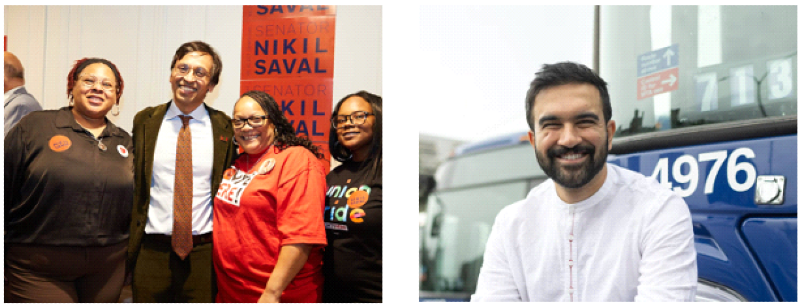
Back in California, Gavin Newsom’s veto of SB 403 did not stop organizing against caste discrimination. In Fresno, Californians of Oaxacan descent joined the Sikh community to fight for and win a successful city-wide ban on caste discrimination, seeing direct parallels to the casta system imposed under centuries of Spanish colonialism and continued discrimination against Mexican-Americans of Indigenous descent. Nearly a century of working side by side in the farmlands of the Central Valley opened a path for mutual recognition and solidarity against intra-community discrimination each community faces in and out of the workplace. In the early 1910s, the anarchist revolutionary Har Dayal set up a political base in Oakland, from where he found success in organizing farmer and farmworker support for the international anti-colonialist Ghadar Movement, which went on to attempt a mass military mutiny against the British Raj in 1915 that was bloodily suppressed.
1/ Today, in a California first, Fresno’s city council voted 7-0 to add caste as a protected category in its anti-discrimination policy! Congrats to our Californians for Caste Equity partners Shri Guru Ravidass Sabha of Fresno & @jakaramovement for securing this amazing victory! pic.twitter.com/XbrjwSMpEf
— Equality Labs (@EqualityLabs) September 28, 2023
Worker solidarity can open up broader possibilities to push back not just against the Hindu nationalist project but other oppressive political projects, rooted in the concrete experience of discrimination at home and at work. Anti-caste politics can foster new solidarity with non-South Asian groups because caste is so nontraditional in terms of how Americans, including leftists, think about the intersection of race and class oppression. These projects carry the potential to pull apart what Roy calls, in reference to the refusal to acknowledge caste injustice in India, a “Project of Unseeing” that mirrors the American right’s crusade against “wokeness,” “DEI,” and cultural pluralism.
Stuart Hall asserted that while ethnicity (like race) is not rooted in biology as contended by the right, it nonetheless "slides toward a transcultural and even transcendental fix in common blood, inheritance and ancestry, all of which gives ethnicity an originary foundation in nature that puts it beyond the reach of history." A winning antidote to the “multiracial far right” that Hindu nationalism seeks to join in the US has to at once fight both the diasporic instinct to cast back to a mythical "there" of the motherland though its reinvention of history, and the internalization of "model minority" politics that demands total assimilation into the American myth of prosperity as progress and even assimilation into whiteness itself.

On February 5th, the Trump administration sent the first-ever India-bound military flight carrying undocumented deportees, locked in shackles, from the United States to Punjab. With the consent and complicity of the Modi government, more flights are soon to follow. A week later, Tulsi Gabbard was sworn in as the first-ever Hindu member of a presidential cabinet, to resounding approval from the Hindu nationalist groups whom she has long befriended. Her first order of business that day was to meet with Prime Minister Modi himself, who had just arrived in Washington to embrace his aspiring strongman-in-arms. A 25-year-old engineer who tweeted “Normalize Indian hate” is busy rooting around in the payment system of the United States Treasury with the approval of the vice president, himself a father of mixed-race South Asian children. The political moment calls for a pan-South Asian-American left as strongly as it does for a reinvigorated American left more broadly.
In 1911, Har Dayal wrote to a Calcutta-based journal with radical optimism about the revolutionary energy he witnessed living among the diaspora. "At present, the people who live in India see only the dark thunder laden ominous clouds... but I have seen the silver lining which is invisible to them: I have found it in Europe and America, but mostly in the latter country... India is not dead but living. Much is being done abroad which is not known at home." Dayal envisioned diaspora as the vanguard of an internationalist movement, developed by and rooted in their experience abroad, that could advance the liberation of their motherland as well as their new land. Perhaps his vision can be renewed.
Shanti Singh is a San Francisco-based housing justice advocate, tenant organizer, and South Asian-American who prefers not to use the term “Hindu-American.” She would like to thank the dozens of anonymous comrades from communities across the diaspora who reached out to share their personal and organizing experiences as inspiration for this piece.


